SUSTAINABLE MANAGEMENT
MATERIAL ISSUES AND PERFORMANCE
KOKUYO’s Material Issues
We have identified six material issues for KOKUYO Group. Under these six themes, we create social value through our businesses.
The six material issues are shown below along with our basic policy for the material issue and the risks and opportunities we have identified.
| Material Issues (materiality) | Basic Policy | Risks and Opportunities | Linked SDGs | |
|---|---|---|---|---|
|
Strategy 1 Improve Wellbeing among Employees and External Stakeholders |
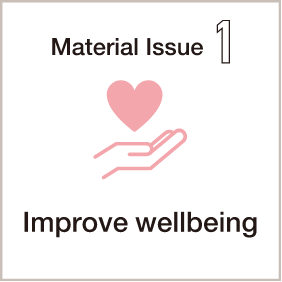
|
We will promote work-life balance, new workstyles, and a diverse workplace (inclusive of gender, disability, and nationality) that produces innovation, so that our corporate group develops products with inclusive design, contributing to wellbeing within our organization and wellbeing in society at large. For this, we have two challenge goals: pitch ideas for new ways of working, and promote diversity, inclusion, and innovation. | Improving the wellbeing of our employees will help us to hire and retain a diversity of creative individuals who are the wellspring of our competitiveness. Supporting these individuals to reach their full potential will enable us continually to create new value and to boost our productivity. Improving the wellbeing of society involves the provision of products and services needed to realize a society in which every individual can play an active role, including those with disabilities. We believe this will enhance our reputation and expand our networks, bringing us more earnings opportunities. |
|
|
Strategy 2 Expand Business Fields through the Forest-Like Management Model |
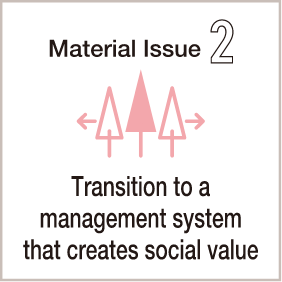 |
Over the years, we’ve offered solutions for new ways of working, learning, and living through a process of first-hand experimentation in which we design experiences for customers through products and services. Amid the plethora of socioenvironmental issues, we want to transform management systems and lead the way to a sustainable future with the support of all employees and businesses. | We will transform our business portfolio by identifying unmet needs and continually creating value aligned with our other material issues (materiality). This will enable us to respond to changes in our operating environment and to continually enhance our corporate value. Evolution of our management system to the Forest-Like Management Model is essential to this endeavor. |
|
|
Strategy 3 Safeguard the Planet as a Place for Work and Life |
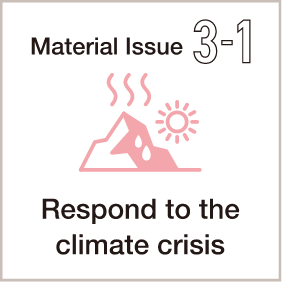 |
Over 90% of our CO2 emissions are from our value chain (scope 3), meaning that we can’t contribute to carbon neutrality on our own. Rather, we work with our supply chain partners on initiatives such as switching to more sustainable raw materials and delivery methods to contribute toward carbon neutrality. | Addressing climate change reduces and prepares us for not only short-term financial risks, such as higher energy or transportation costs, but also future physical risks and the risk of rising environmental costs. We expect that the supply of low-emissions products and solutions and the enhancement of our brand image will increase our earnings opportunities and boost our external valuation, and that this will support our share price. |
|
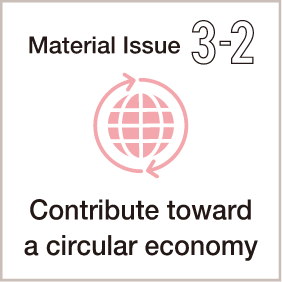 |
We want to use the planet’s limited resources efficiently. Accordingly, we’ve been working to recycle more of our waste and to develop ecologically sustainable products and services. As an organization that provides products that are as accessible to as many people as possible, we also aim to promote individuated zero-waste lifestyles. | We will reduce risk from resource procurement and reputational damage by recovering and reusing resources. Winning the support of consumers looking for more sustainable products will increase our business opportunities while resource recycling will help us build a lasting relationship with many customers. This should increase our earnings from maintenance, updating and other services. | ||
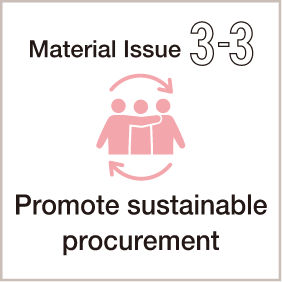 |
With the rapid progress of economic globalization, multinational corporations have grown massive, while human rights issues such as forced labor and child labor in supply chains extending to developing countries in pursuit of low costs, widening wealth disparities and environmental degradation have become more and more serious. Our group will fulfill its social responsibilities together with suppliers and continue contributing to social development. | Avoiding consumer boycott and similar risks by addressing human rights and environmental risks in our supply chains is essential to the sustainability of our business. Communicating such initiatives to our customers will enable us to market products at prices that fairly reflect the costs of addressing these risks. | ||
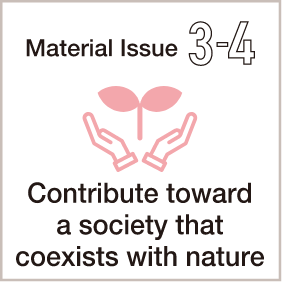 |
Conservation of forests is a major imperative for us since we use plenty of timber (not least in our mainstay products of notebooks and office furniture). Over the years, we have worked to conserve biodiversity and reduce our use of hazardous materials in order to minimize our impact on the environment. We will monitor and take steps to improve our impact on the environment so that we can balance business activities with natural capital for a healthier planet. |
We strive to understand biodiversity as well as the risks relating to our raw materials and the environmental risks to our business sites and their surrounds. We aim thereby to achieve business operations in balance with natural capital and hence stable raw material procurement and sustainable business. We believe this will resonate with our customers and maintain, if not strengthen, our brand image, feeding through into increased earnings. | ||

Material Issues and Performance
In December 2024, we set targets for 2027 to guide us in materiality actions aligned with our corporate strategies (as set out in our long-term vision and fourth medium-term plan).
Shown below are the targets and results for each material issue.
| Strategic Theme | Material Issue | target 2024 |
result 2024 |
Key actions taken in 2024 | target 2027 |
challenge-target 2030 |
|---|---|---|---|---|---|---|
| 1. Improve Wellbeing among Employees and External Stakeholders |
1-1 Pitch ideas for new workstyles |
1) Shift to mindset that values employees’ disposable time ・Take-up of paid leave by managers and employees: 100% |
・71.1% (five group companies) | ・Provided programs to empower diverse employees | ・Take-up of paid leave: 100% | Challenge goals for flexible and diverse work options: 27 challenge goals (three per year for nine years) |
| ・Percentage of leadership roles occupied by women: 12% | ・10.9% (five group companies) | ・Percentage of management posts held by women: 16% | ||||
| 1-2 Promote diversity, inclusion, and innovation |
2) ・Percentage of new product series that incorporate inclusive design: At least 20% |
・26.6% | ・Developed products with inclusive design | ・Percentage of new products that incorporate inclusive design: At least 35% | Percentage of new product series that incorporate inclusive design: At least 50% | |
| 2. Expand Business Fields through the Forest-Like Management Model |
Transforming management systems for social value creation |
3) ・Number of visionary idea (Mirai Yokoku) experiments (3rd medium-term plan total): 30 or more |
・11 (3rd medium-term plan total:33) |
Ran organization-wide events for learning about sustainability | ・Number of visionary idea (Mirai Yokoku) experiments (4th medium-term plan total): 30 | Percentage of sales with balanced social value and economic value: 100% |
| ・Rate of participation in sustainability initiatives: 100% | ・90.2% | ・Percentage of employees addressing socioeconomic issues through their job: 100% | Percentage of employees addressing social issues: 100% | |||
| 3. Safeguard the Planet as a Place for Work and Life |
3-1 Respond to the climate crisis |
4) ・Reduce CO2 emissions: Reduce CO2 emissions in Japan by 50% compared to 2013 |
・54.1% |
・Shifted workplaces (offices and plants) to renewables energy ・Obtained SBTi validation |
Scopes 1 and 2 ・35% reduction in CO2 emissions from 2022 level |
Scopes 1 and 2 Reduce Scope 1 & 2 greenhouse gas emissions by 42% between 2022 and 2030 Scope 3 ・Reduce greenhouse gas emissions from the Scope 3 category “purchased goods and services” by 25% between 2022 and 2030 ・Have suppliers, responsible for 12.5% of our emissions from “purchased goods and services,” set SBTi goals by 2028 |
|
Scope 3 ・Set SBTi goals with suppliers (responsible for 125,000 t-CO2) ・Complete formulation of action plan for achieving 2030 goals |
||||||
| Carbon absorption: At least 6,000 t-CO2 absorbed a year | ||||||
| 3-2 Contribute toward a circular economy |
5) ・Percentage of new products incorporating circular-business guidelines: 100% |
・100% |
・Developed products aligned with circular-business guidelines ・Developed services related to the transition to a circular economy |
・Percentage of net sales attributable to products that incorporate circular-business guidelines: 40% | Percentage of net sales attributable to products sold by group (including overseas companies) that support a transition to a circular economy: At least 80% | |
| ・Recycling rate for general business waste (including dead stock): 97% | ||||||
| ・Recycling rate for plastic waste: 100% | Recycling rate for waste (from offices, worksites, and warehouses): 100% | |||||
| ・Reduction in mixed construction waste from 2023 level: 75% | ||||||
| 3-3 Facilitating sustainable procurement |
6) ・Percentage of key suppliers (some 400 companies) providing feedback (evaluations, issues to address) in supplier evaluation survey: 100% |
・We surveyed 566 suppliers and supplied feedback to the 501 that responded (88.5% response rate) | ・Conducted questionnaire survey among suppliers and engaged with them to address the issues identified in survey | ・Percentage of products sourced from suppliers ranked B or above: At least 75% | ・Percentage of products sourced from suppliers ranked B or above: 100% | |
| 3-4 Contribute toward a society that coexists with nature |
- | - |
・Established KOKUYO Group Paper and Timber Procurement Standards ・Contributed to forest and reedbed conservation |
・Percentage of net sales attributable to products that satisfy KOKUYO Group Paper and Timber Procurement Standards: 75% | Carbon footprint of business activities visualized and carbon neutrality achieved | |
| ・Visually representing environmental impacts: Complete visualization process in all major businesses | ||||||
| ・Number of environmental conservation projects: 3 | Forest conservation: Forests thinned at about 150 hectares a year | |||||
| Reedbed conservation: Reeds trimmed at about 1.5 hectares a year |

-
*1) applies to the following entities: Kaunet, KOKUYO Marketing, KOKUYO Supply Logistics, and KOKUYO Logitem Co., Ltd.
-
*2)3)5)6) have a smaller coverage. In future reporting, we will standardize the coverage to encompass consolidated subsidiaries inside and outside Japan.













